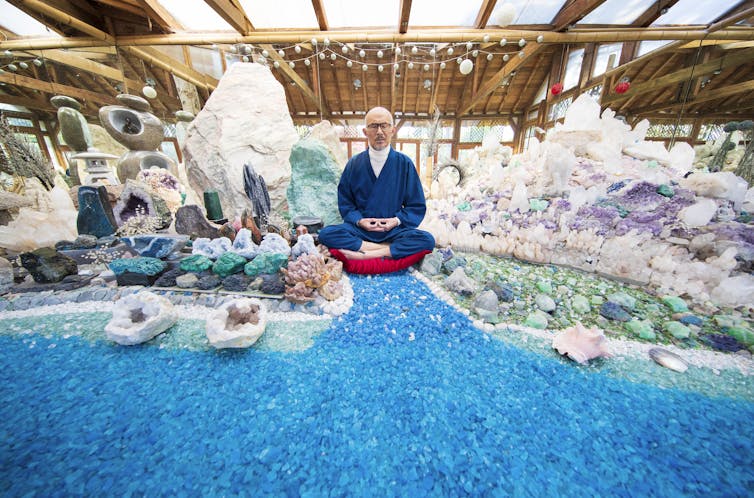From Jesus and the Shamanic Tradition of Same-Sex Love
by Will Roscoe,
Originally in White Crane issue #63, winter 2005, Totems and Animal Wisdom:
In 1979, I
attended a retreat where Hay passionately presented his idea concerning
subject-Subject consciousness and called on us as Gay men to foster it.
At that event I discovered I was not alone in yearning to incorporate a
spiritual outlook into my life. For many of us, a spiritual inclination
began in childhood with a fantasy life that included talking to trees
and animals, and inventing rituals. As we shared these experiences at
the 1979 retreat, we realized that Gay spirituality begins with
reclaiming the child-like awareness we had before the crippling and
stifling influence of homophobia penetrated our lives. Whitman had a
similar intuition and frequently celebrated boyhood. In “There was a
Child Went Forth,” he describes the child’s awareness in terms that
resonate with Hay’s concept of subject-subject:
There was a child went forth every day,
And the first object he look’d upon, that object he became,
And that object became part of him
But in 1979
adhesive love and subject-subject consciousness were ideals not
realities. In those years, it was difficult to see anything redeeming in
the way that Gay men were pursuing love. The activist, experimental era
of Gay liberation was over. A grassroots movement of volunteer and
self-help organizations was being replaced by agencies staffed with
professionals. Gay marches had become Gay parades, and Gay social life
was shifting from public and community-organized events to commercial
venues.
Discussions of
Gay love gave way to a narrower focus on sexuality. Self-identified sex
radicals claimed that simply having Gay sex challenged the social
system, while moderates claimed that sex was the only thing that
distinguished lesbians, Gay men, and bisexuals from heterosexuals, and,
since it was a private act, it was an invisible difference. In either
case, sex was the lynchpin of Gay identity. To be Gay or bisexual was to
have sex. At the same time, many Gays, lesbians, and bisexuals were
rejecting the idea advanced by earlier liberationists that they might be
gender different. The assimilationist mantra took its place: “We’re no
different from heterosexuals except for what we do in bed.”
In the 1970s, to
live up to their image as sexual athletes, Gay men began using drugs and
alcohol at rates far in excess of the general population. Our sexual
experiences became increasingly intense, but they occurred in contexts
that attributed them with no particular significance. Gay men began
referring to sex as “play”—it became a form of recreation, to be
consumed much as entertainment or travel or fashion. Far from posing a
challenge to the social order, it turned out that a sexual minority
community whose identity was derived from what it consumed was perfectly
compatible with postindustrial capitalism.
All this occurred
as an organized anti-Gay opposition was emerging. In 1977, Anita
Bryant’s campaign in Dade County, Florida overturned legislation to
protect Gays from discrimination. Soon Gay civil rights protections were
being repealed throughout the country. Heterosexual Americans were not
ready to see Gay lifestyles or relationships as equal to theirs in any
way, nor were they willing to entertain the possibility that Gays were
different in ways that might be beneficial. Indeed, Gays themselves
increasingly rejected such speculations as elitist, throwbacks to a
discredited model of homosexuality as inborn and essential. Lesbian and
Gay intellectuals, under the influence of Michel Foucault and the theory
of social constructionism, not only decried the idea of queer
differences, the very desire to explore the meaning of one’s sexual
identity was dismissed out of hand.
In 1982, at the same time I was reading Clement of Alexandria,
I decided to write an essay expressing my dismay at the role of sexual
objectification in the Gay men’s community. Instead of healing the
wounds inflicted on us by a homophobic society, we were perpetuating low
self-esteem. And the consequences of this, I argued, could be seen in a
growing range of health problems appearing among Gay men—from
alcoholism to sexually transmitted diseases to recent reports of a new
and mysterious illness that was taking Gay men’s lives.
My essay, titled
“Desperate Living” (after a popular John Waters’ film), was published
about the same time that I put down Smith’s book. Our extended stay with
Harry and his partner John in Los Angeles was over. Brad and I were
still young, in our twenties, and life flowed in strong currents. We
found ourselves back in San Francisco, immersed in new jobs and new
projects.
Fifteen years
passed before I took up Smith’s book again. It was 1997, and I had been
invited to speak at Gay Spirit Visions, an annual conference held
outside Atlanta, Georgia. The theme was mentoring. As I thought about
this topic, it occurred to me that Gay men needed not only
mentors—teachers, guides, role models—but also some form of initiatory
experience to mark their passage from the closet to community and from
Gay childhood to Gay adulthood.
Then I remembered
the mystical rite of initiation uncovered by Morton Smith. As I began
re-reading his book, I saw connections that had escaped me before. I
realized how Jesus’ secret baptism drew on ideas and images with a long
history, and how it was that same-sex love could be part of, indeed,
give rise to, visionary experiences. I realized as well that the
insights I was having now were the result of what I had experienced in
the fifteen years since I last picked up Smith’s book.
Those were the
years when the AIDS epidemic swept through our lives like wildfire,
whisking away acquaintances, friends, and lovers—and, eventually, my own
life partner.
Excerpt reprinted from Jesus and the Shamanic Tradition of Same-Sex Love by Will Roscoe (Suspect Thoughts Press) courtesy of the author.



































